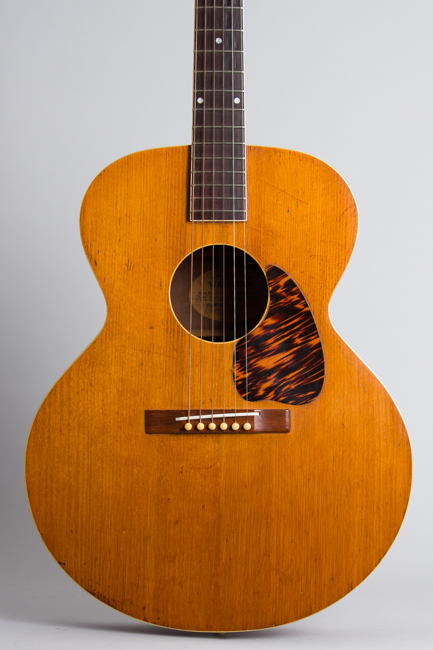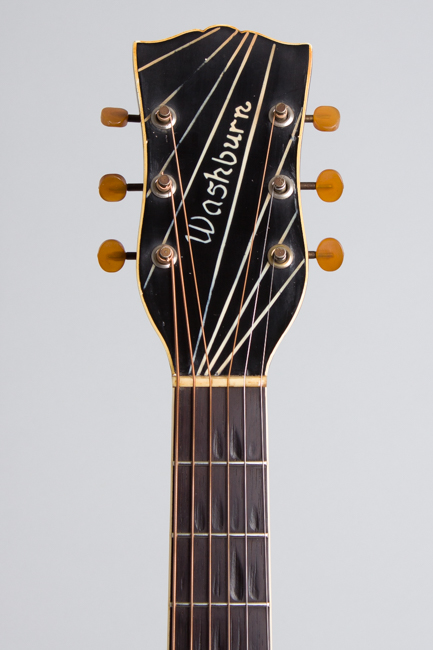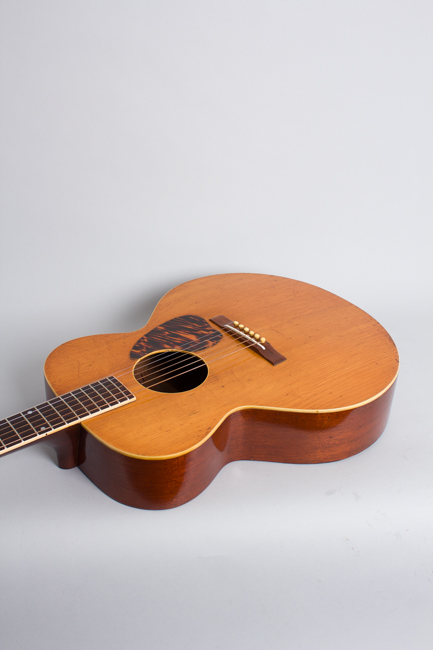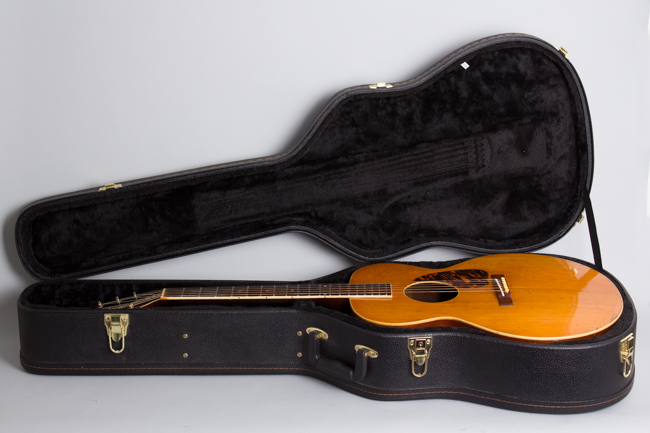Washburn Model 5241 Classic Flat Top Acoustic Guitar, made by Gibson (1939)
This item has been sold.
Item # 11840
Prices subject to change without notice.
Washburn Model 5241 Classic Model Flat Top Acoustic Guitar, made by Gibson (1939), made in Kalamazoo, Michigan, natural lacquer finish, mahogany back, sides and neck,spruce top, rosewood fingerboard, black tolex hard shell case.
This very rare and interesting pre-war 16" Jumbo guitar has two famous names behind it; "Washburn" on the headstock, and Gibson who actually built the instrument. Washburn had been Lyon & Healy's premium instrument brand from the 1880s through 1928; after that it passed to Tonk Bros, another Chicago jobber. Tonk used it on their better fretted products sourced the actual building to different suppliers, primarily Regal. For a short time in the late 1930s Gibson picked up some of this contract work, resulting in a limited number of very nice Washburns born in Kalamazoo between 1938 and 1940.
This Gibson-made 5241 "Classic" Model is one of them. It is a large instrument for the time with a ladder braced spruce top over mahogany back and sides. The natural-finish top is bound in white celluloid, with a bound sound hole edge and small rectangular rosewood bridge. The 14-fret mahogany neck has the typical if fairly slim 1930s Gibson "V" profile, with a bound rosewood fingerboard and pearl dot inlay. The large and strikingly unusual peghead design has a very deco look with diagonal lines stenciled over Celluloid showcasing the "Washburn" logo. It is outfitted with Kluson strip tuners sporting cool translucent plastic buttons specific to this period.
This is basically a "Super Kalamazoo", bigger and more refined than anything Gibson built under that name. Like all of Gibson's off-brand pre-war instruments it does not have an adjustable truss rod but is otherwise made with the company's standard quality materials and workmanship. This "Classic" is basically a 16" arch-top body form with a flat top, something Gibson did not make under their own name at the time. In the 1950s the highly esteemed J-185 would use the same basic shape, with rounded bouts and a comparatively narrow waist. The 5241 is not quite in a league with that model as it has a shallower body and straight braced top (instead of X braced) which is the way nearly all the secondary line instruments were built. Still this combination of features gives the "Classic" a unique tone, big but somewhat less sweet than many Gibsons, more in the Jumbo Stella mode. The 5241 makes a very fine fingerstyle blues guitar but also is a nice "cowboy" strumming machine.
Some of the 5241s were built by Regal in Chicago; their version has a 20 fret fingerboard while the Gibsons have only 19. Gibson-built 5241s also can be easily distinguished by their distinctive "firestripe" celluloid pickguard, which Regal did not use. The Regal version is built a bit heavier all around, and while a nice instrument on its own merits is not the sonic equal of this Kalamazoo-made example. Gibson's shipping ledgers show only 57 of this model were sent to Tonk starting September 1939, making it an extremely rare guitar. While not an expensive guitar when new this is a high quality and very unique instrument, a cool piece of pre-war Gibson history and a lovely guitar to play.
Overall length is 41 in. (104.1 cm.), 16 1/16 in. (40.8 cm.) wide at lower bout, and 3 15/16 in. (10 cm.) in depth at side, taken at the end block. Scale length is 24 3/4 in. (629 mm.). Width of nut is 1 11/16 in. (43 mm.).
This guitar remains in nicely original condition showing some general wear overall, mostly a seemingly random scratching and dings to finish particularly on the top and back. There is not as much pick wear as we often see on older guitars of this type. The neck finish is fairly well worn down to the wood over much of its length, particularly on the bass side. There is some wear to the decorated headstock, but much of the graphics are still intact.
The neck has been neatly reset and refretted with period appropriate wire so playability is excellent. There is some noticeable divoting to the fingerboard in the lower positions. The bridge and long, thin bridge plate are original; the bridge has been very neatly reglued and has a new bone saddle. The bridgeplate has wear at the pinholes, several of which have been cleanly filled with round wood patches; the pins appear original. The top is slightly arched as most of these are, but fully stable.
This is a very interesting and unusual-sounding guitar with a tone all its own. The large 16" body, ladder bracing, and high quality construction combine to make a loud but surprisingly sweet-toned instrument, excellent for both fingerstyle and straight strumming. Considering its extreme rarity, this is a well-preserved example of a guitar even most vintage flat-top fans have ever seen. Overall Excellent - Condition.
This very rare and interesting pre-war 16" Jumbo guitar has two famous names behind it; "Washburn" on the headstock, and Gibson who actually built the instrument. Washburn had been Lyon & Healy's premium instrument brand from the 1880s through 1928; after that it passed to Tonk Bros, another Chicago jobber. Tonk used it on their better fretted products sourced the actual building to different suppliers, primarily Regal. For a short time in the late 1930s Gibson picked up some of this contract work, resulting in a limited number of very nice Washburns born in Kalamazoo between 1938 and 1940.
This Gibson-made 5241 "Classic" Model is one of them. It is a large instrument for the time with a ladder braced spruce top over mahogany back and sides. The natural-finish top is bound in white celluloid, with a bound sound hole edge and small rectangular rosewood bridge. The 14-fret mahogany neck has the typical if fairly slim 1930s Gibson "V" profile, with a bound rosewood fingerboard and pearl dot inlay. The large and strikingly unusual peghead design has a very deco look with diagonal lines stenciled over Celluloid showcasing the "Washburn" logo. It is outfitted with Kluson strip tuners sporting cool translucent plastic buttons specific to this period.
This is basically a "Super Kalamazoo", bigger and more refined than anything Gibson built under that name. Like all of Gibson's off-brand pre-war instruments it does not have an adjustable truss rod but is otherwise made with the company's standard quality materials and workmanship. This "Classic" is basically a 16" arch-top body form with a flat top, something Gibson did not make under their own name at the time. In the 1950s the highly esteemed J-185 would use the same basic shape, with rounded bouts and a comparatively narrow waist. The 5241 is not quite in a league with that model as it has a shallower body and straight braced top (instead of X braced) which is the way nearly all the secondary line instruments were built. Still this combination of features gives the "Classic" a unique tone, big but somewhat less sweet than many Gibsons, more in the Jumbo Stella mode. The 5241 makes a very fine fingerstyle blues guitar but also is a nice "cowboy" strumming machine.
Some of the 5241s were built by Regal in Chicago; their version has a 20 fret fingerboard while the Gibsons have only 19. Gibson-built 5241s also can be easily distinguished by their distinctive "firestripe" celluloid pickguard, which Regal did not use. The Regal version is built a bit heavier all around, and while a nice instrument on its own merits is not the sonic equal of this Kalamazoo-made example. Gibson's shipping ledgers show only 57 of this model were sent to Tonk starting September 1939, making it an extremely rare guitar. While not an expensive guitar when new this is a high quality and very unique instrument, a cool piece of pre-war Gibson history and a lovely guitar to play.
Overall length is 41 in. (104.1 cm.), 16 1/16 in. (40.8 cm.) wide at lower bout, and 3 15/16 in. (10 cm.) in depth at side, taken at the end block. Scale length is 24 3/4 in. (629 mm.). Width of nut is 1 11/16 in. (43 mm.).
This guitar remains in nicely original condition showing some general wear overall, mostly a seemingly random scratching and dings to finish particularly on the top and back. There is not as much pick wear as we often see on older guitars of this type. The neck finish is fairly well worn down to the wood over much of its length, particularly on the bass side. There is some wear to the decorated headstock, but much of the graphics are still intact.
The neck has been neatly reset and refretted with period appropriate wire so playability is excellent. There is some noticeable divoting to the fingerboard in the lower positions. The bridge and long, thin bridge plate are original; the bridge has been very neatly reglued and has a new bone saddle. The bridgeplate has wear at the pinholes, several of which have been cleanly filled with round wood patches; the pins appear original. The top is slightly arched as most of these are, but fully stable.
This is a very interesting and unusual-sounding guitar with a tone all its own. The large 16" body, ladder bracing, and high quality construction combine to make a loud but surprisingly sweet-toned instrument, excellent for both fingerstyle and straight strumming. Considering its extreme rarity, this is a well-preserved example of a guitar even most vintage flat-top fans have ever seen. Overall Excellent - Condition.












